树结构的基础部分
二叉树
为什么需要树这种数据结构
- 数组存储方式的分析
优点:通过下标方式访问元素,速度快。对于有序数组,还可使用二分查找提高检索速度。
缺点:如果要检索具体某个值,或者插入值(按一定顺序)会整体移动,效率较低 [示意图]
画出操作示意图:

- 链式存储方式的分析
优点:在一定程度上对数组存储方式有优化(比如:插入一个数值节点,只需要将插入节点,链接到链表中即可,删除效率也很好)。
缺点:在进行检索时,效率仍然较低,比如(检索某个值,需要从头节点开始遍历) - 树存储方式的分析
能提高数据存储,读取的效率, 比如利用 二叉排序树(Binary Sort Tree),既可以保证数据的检索速度,同时也
可以保证数据的插入,删除,修改的速度。【示意图,后面详讲】
案例: [7, 3, 10, 1, 5, 9, 12]

树示意图
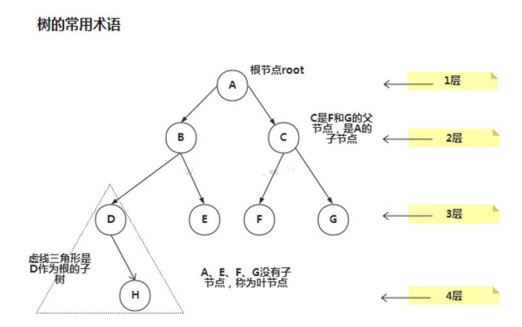
树的常用术语(结合示意图理解):
- 节点
- 根节点
- 父节点
- 子节点
- 叶子节点 (没有子节点的节点)
- 节点的权(节点值)
- 路径(从 root 节点找到该节点的路线)
- 层
- 子树
- 树的高度(最大层数)
- 森林 :多颗子树构成森林
二叉树的概念
- 树有很多种,每个节点最多只能有两个子节点的一种形式称为二叉树。
- 二叉树的子节点分为左节点和右节点
- 示意图
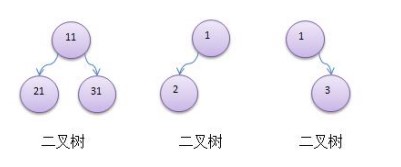
- 如果该二叉树的所有叶子节点都在最后一层,并且结点总数= 2^n -1 , n 为层数,则我们称为满二叉树。

- 如果该二叉树的所有叶子节点都在最后一层或者倒数第二层,而且最后一层的叶子节点在左边连续,倒数第二
层的叶子节点在右边连续,我们称为完全二叉树
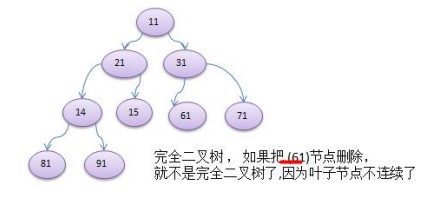
二叉树遍历的说明
使用前序,中序和后序对下面的二叉树进行遍历.
- 前序遍历: 先输出父节点,再遍历左子树和右子树
- 中序遍历: 先遍历左子树,再输出父节点,再遍历右子树
- 后序遍历: 先遍历左子树,再遍历右子树,最后输出父节点
- 小结: 看输出父节点的顺序,就确定是前序,中序还是后序
二叉树遍历应用实例(前序,中序,后序)
- 应用实例的说明和思路
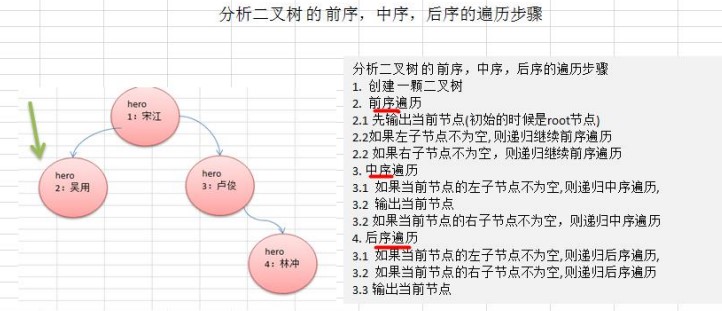
- 代码实现
package com.atguigu.tree;
public class BinaryTreeDemo {
public static void main(String[] args) {
//先需要创建一颗二叉树
BinaryTree binaryTree = new BinaryTree();
//创建需要的结点
HeroNode root = new HeroNode(1, "宋江");
HeroNode node2 = new HeroNode(2, "吴用");
HeroNode node3 = new HeroNode(3, "卢俊义");
HeroNode node4 = new HeroNode(4, "林冲");
HeroNode node5 = new HeroNode(5, "关胜");
//说明,我们先手动创建该二叉树,后面我们学习递归的方式创建二叉树
root.setLeft(node2);
root.setRight(node3);
node3.setRight(node4);
node3.setLeft(node5);
binaryTree.setRoot(root);
//测试
System.out.println("前序遍历"); // 1,2,3,5,4
binaryTree.preOrder();
//测试
System.out.println("中序遍历");
binaryTree.infixOrder(); // 2,1,5,3,4
//
System.out.println("后序遍历");
binaryTree.postOrder(); // 2,5,4,3,1
}
}
//定义 BinaryTree 二叉树
class BinaryTree {
private HeroNode root;
public void setRoot(HeroNode root) {
this.root = root;
}
//前序遍历
public void preOrder() {
if(this.root != null) {
this.root.preOrder();
}else {
System.out.println("二叉树为空,无法遍历");
}
}
//中序遍历
public void infixOrder() {
if(this.root != null) {
this.root.infixOrder();
}else {
System.out.println("二叉树为空,无法遍历");
}
}
//后序遍历
public void postOrder() {
if(this.root != null) {
this.root.postOrder();
}else {
System.out.println("二叉树为空,无法遍历");
}
}
}
//先创建 HeroNode 结点
class HeroNode {
private int no;
private String name;
private HeroNode left; //默认 null
private HeroNode right; //默认 null
public HeroNode(int no, String name) {
this.no = no;
this.name = name;
}
public int getNo() {
return no;
}
public void setNo(int no) {
this.no = no;
}
public String getName() {
return name;
}
public void setName(String name) {
this.name = name;
}
public HeroNode getLeft() {
return left;
}
public void setLeft(HeroNode left) {
this.left = left;
}
public HeroNode getRight() {
return right;
}
public void setRight(HeroNode right) {
this.right = right;
}
@Override
public String toString() {
return "HeroNode [no=" + no + ", name=" + name + "]";
}
//编写前序遍历的方法
public void preOrder() {
System.out.println(this); //先输出父结点
//递归向左子树前序遍历
if(this.left != null) {
this.left.preOrder();
}
//递归向右子树前序遍历
if(this.right != null) {
this.right.preOrder();
}
}
//中序遍历
public void infixOrder() {
//递归向左子树中序遍历
if(this.left != null) {
this.left.infixOrder();
}
//输出父结点
System.out.println(this);
//递归向右子树中序遍历
if(this.right != null) {
this.right.infixOrder();
}
}
//后序遍历
public void postOrder() {
if(this.left != null) {
this.left.postOrder();
}
if(this.right != null) {
this.right.postOrder();
}
System.out.println(this);
}
}
二叉树-查找指定节点
要求
- 请编写前序查找,中序查找和后序查找的方法。
- 并分别使用三种查找方式,查找 heroNO = 5 的节点
- 并分析各种查找方式,分别比较了多少次
- 思路分析图解

- 代码实现
package com.atguigu.tree;
public class BinaryTreeDemo {
public static void main(String[] args) {
BinaryTree binaryTree = new BinaryTree();
HeroNode root = new HeroNode(1, "qq");
HeroNode node2 = new HeroNode(2, "ww");
HeroNode node3 = new HeroNode(3, "rr");
HeroNode node4 = new HeroNode(4, "tt");
HeroNode node5 = new HeroNode(5, "yy");
root.setLeft(node2);
root.setRight(node3);
node3.setRight(node4);
node3.setLeft(node5);
binaryTree.setRoot(root);
System.out.println("前序遍历");
binaryTree.preOrder();
System.out.println("中序遍历");
binaryTree.infixOrder();
System.out.println("后序遍历");
binaryTree.postOrder();
// System.out.println("前序遍历查找");
// HeroNode resNOde = binaryTree.preOrdersearch(5);
// if (resNOde!=null) {
// System.out.printf("找到了,信息为no=%d name=%s",resNOde.getNo(),resNOde.getName());
//
// }
// System.out.println("中序遍历查找");
// HeroNode resNOde = binaryTree.infixOrdersearch(5);
// if (resNOde!=null) {
// System.out.printf("找到了,信息为no=%d name=%s",resNOde.getNo(),resNOde.getName());
//
// }
// System.out.println("后序遍历查找");
// HeroNode resNOde = binaryTree.postOrderseach(5);
// if (resNOde!=null) {
// System.out.printf("找到了,信息为no=%d name=%s",resNOde.getNo(),resNOde.getName());
//
// }else {
// System.out.println("没有找到"+5);
// }
System.out.println("删除前:");
binaryTree.preOrder();
binaryTree.delNode(5);
System.out.println("删除后:");
binaryTree.preOrder();
}
}
class BinaryTree{
private HeroNode root;
public void setRoot(HeroNode root) {
this.root = root;
}
public void delNode(int no) {
if (root!=null) {
if (root.getNo()==no) {
root=null;
}else {
root.delNode(no);
}
}else {
System.out.println("空树,不能删除");
}
}
public void preOrder() {
if (this.root!=null) {
this.root.preOrder();
}else {
System.out.println("二叉树为空,无法遍历");
}
}
public HeroNode preOrdersearch(int no) {
if (root!=null) {
return root.preOrdersearch(no);
}else {
return null;
}
}
public void infixOrder() {
if (this.root!=null) {
this.root.infixOrder();
}else {
System.out.println("二叉树为空,无法遍历");
}
}
public HeroNode infixOrdersearch(int no) {
if (root!=null) {
return root.infixOrdersearch(no);
}else {
return null;
}
}
public void postOrder() {
if (this.root!=null) {
this.root.postOrder();
}else {
System.out.println("二叉树为空,无法遍历");
}
}
public HeroNode postOrderseach(int no) {
if (root!=null) {
return root.postOrdersearch(no);
}else {
return null;
}
}
}
class HeroNode{
private int no;
private String name;
private HeroNode left;
private HeroNode right;
public HeroNode(int no, String name) {
super();
this.no = no;
this.name = name;
}
public int getNo() {
return no;
}
public void setNo(int no) {
this.no = no;
}
public String getName() {
return name;
}
public void setName(String name) {
this.name = name;
}
public HeroNode getLeft() {
return left;
}
public void setLeft(HeroNode left) {
this.left = left;
}
public HeroNode getRight() {
return right;
}
public void setRight(HeroNode right) {
this.right = right;
}
@Override
public String toString() {
return "HeroNode [no=" + no + ", name=" + name + "]";
}
public void delNode(int no) {
if (this.left!=null && this.left.no==no) {
this.left=null;
return;
}
if (this.right!=null && this.right.no==no) {
this.right=null;
return;
}
if (this.left!=null) {
this.left.delNode(no);
}
if (this.right!=null) {
this.right.delNode(no);
}
}
public void preOrder() {
System.out.println(this);
if (this.left!=null) {
this.left.preOrder();
}
if (this.right!=null) {
this.right.preOrder();
}
}
public HeroNode preOrdersearch(int no) {
System.out.println("进入前序遍历");
if (this.no==no) {
return this;
}
HeroNode resNode=null;
if (this.left!=null) {
resNode = this.left.preOrdersearch(no);
}
if(resNode!=null){
return resNode;
}
if (this.right!=null) {
resNode=this.right.preOrdersearch(no);
}
if(resNode!=null){
return resNode;
}
return resNode;
}
public void infixOrder() {
if (this.left!=null) {
this.left.infixOrder();
}
System.out.println(this);
if (this.right!=null) {
this.right.infixOrder();
}
}
public HeroNode infixOrdersearch(int no) {
HeroNode resNode=null;
if (this.left!=null) {
resNode = this.left.infixOrdersearch(no);
}
if(resNode!=null){
return resNode;
}
System.out.println("进入中序遍历");
if (this.no==no) {
return this;
}
if (this.right!=null) {
resNode=this.right.infixOrdersearch(no);
}
if(resNode!=null){
return resNode;
}
return resNode;
}
public void postOrder() {
if (this.left!=null) {
this.left.postOrder();
}
if (this.right!=null) {
this.right.postOrder();
}
System.out.println(this);
}
public HeroNode postOrdersearch(int no) {
HeroNode resNode=null;
if (this.left!=null) {
resNode = this.left.postOrdersearch(no);
}
if(resNode!=null){
return resNode;
}
if (this.right!=null) {
resNode=this.right.postOrdersearch(no);
}
if(resNode!=null){
return resNode;
}
System.out.println("进入后序遍历");
if (this.no==no) {
return this;
}
return resNode;
}
}
二叉树-删除节点
要求
如果删除的节点是叶子节点,则删除该节点
如果删除的节点是非叶子节点,则删除该子树.
测试,删除掉 5 号叶子节点 和 3 号子树.
完成删除思路分析
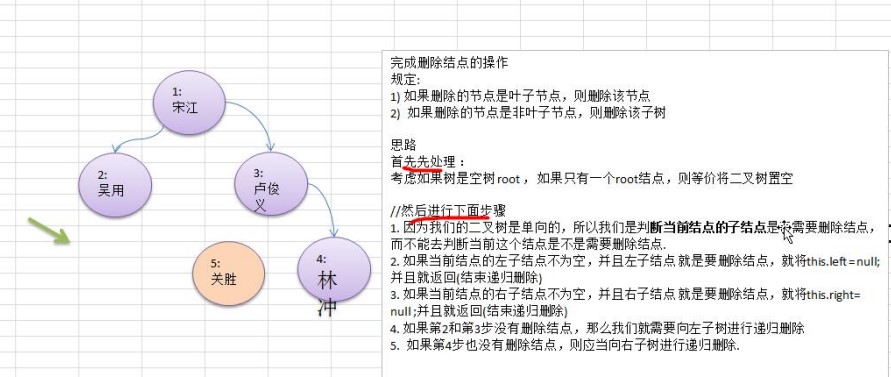
5) 代码实现
//HeroNode 类增加方法
//递归删除结点
//1.如果删除的节点是叶子节点,则删除该节点
//2.如果删除的节点是非叶子节点,则删除该子树
public void delNode(int no) {
//思路
/*
* 1. 因为我们的二叉树是单向的,所以我们是判断当前结点的子结点是否需要删除结点,而不能去判断
当前这个结点是不是需要删除结点.
2. 如果当前结点的左子结点不为空,并且左子结点 就是要删除结点,就将 this.left = null; 并且就返回
(结束递归删除)
3. 如果当前结点的右子结点不为空,并且右子结点 就是要删除结点,就将 this.right= null ;并且就返回
(结束递归删除)
4. 如果第 2 和第 3 步没有删除结点,那么我们就需要向左子树进行递归删除
5. 如果第 4 步也没有删除结点,则应当向右子树进行递归删除. */
//2. 如果当前结点的左子结点不为空,并且左子结点 就是要删除结点,就将 this.left = null; 并且就返回(结束递归删除)
if(this.left != null && this.left.no == no) {
this.left = null;
return;
}
//3.如果当前结点的右子结点不为空,并且右子结点 就是要删除结点,就将 this.right= null ;并且就返回(结
束递归删除)
if(this.right != null && this.right.no == no) {
this.right = null;
return;
}
//4.我们就需要向左子树进行递归删除
if(this.left != null) {
this.left.delNode(no);
}
//5.则应当向右子树进行递归删除
if(this.right != null) {
this.right.delNode(no);
}
}
//在 BinaryTree 类增加方法
//删除结点
public void delNode(int no) {
if(root != null) {
//如果只有一个 root 结点, 这里立即判断 root 是不是就是要删除结点
if(root.getNo() == no) {
root = null;
} else {
//递归删除
root.delNode(no);
}
}else{
System.out.println("空树,不能删除~");
}
}
//在 BinaryTreeDemo 类增加测试代码:
//测试一把删除结点
System.out.println("删除前,前序遍历");
binaryTree.preOrder(); // 1,2,3,5,4
binaryTree.delNode(5);
//binaryTree.delNode(3);
System.out.println("删除后,前序遍历");
binaryTree.preOrder();
- 如果要删除的节点是非叶子节点,现在我们不希望将该非叶子节点为根节点的子树删除,需要指定规则, 假如
规定如下: - 如果该非叶子节点 A 只有一个子节点 B,则子节点 B 替代节点 A
- 如果该非叶子节点 A 有左子节点 B 和右子节点 C,则让左子节点 B 替代节点 A。
顺序存储二叉树
顺序存储二叉树的概念
- 基本说明
从数据存储来看,数组存储方式和树的存储方式可以相互转换,即数组可以转换成树,树也可以转换成数组,
看右面的示意图。
- 要求:
- 右图的二叉树的结点,要求以数组的方式来存放 arr : [1, 2, 3, 4, 5, 6, 6]
- 要求在遍历数组 arr 时,仍然可以以前序遍历,中序遍历和后序遍历的方式完成结点的遍历
- 顺序存储二叉树的特点:
- 顺序二叉树通常只考虑完全二叉树
- 第 n 个元素的左子节点为 2 * n + 1
- 第 n 个元素的右子节点为 2 * n + 2
- 第 n 个元素的父节点为 (n-1) / 2
- n : 表示二叉树中的第几个元素(按 0 开始编号如图所示)
顺序存储二叉树遍历
需求: 给你一个数组 {1,2,3,4,5,6,7},要求以二叉树前序遍历的方式进行遍历。 前序遍历的结果应当为 1,2,4,5,3,6,7
代码实现:
package com.atguigu.tree;
public class ArrBinaryTreeDemo {
//(用数组存储)第n个元素(从0开始)的左节点为2*n+1;右结点为2*n+2;父结点为(n-1)/2
public static void main(String[] args) {
int[] arr={1,2,3,4,5,6,7};
ArrBineryTree arrbinaryTree = new ArrBineryTree(arr);
System.out.println("前序遍历");
arrbinaryTree.preOrder(0);
System.out.println();
System.out.println("中序遍历");
arrbinaryTree.infixOrder(0);
System.out.println();
System.out.println("后序遍历");
arrbinaryTree.postOrder(0);
}
}
class ArrBineryTree{
private int[] arr;
public ArrBineryTree(int[] arr) {
super();
this.arr = arr;
}
public void preOrder() {
this.preOrder(0);
}
public void preOrder(int index) {
if (arr.length==0 || arr==null) {
System.out.println("数组为空,不能按照二叉树的前序遍历");
}
System.out.print(arr[index]+" ");
if (2*index+1<arr.length) {
preOrder(2*index+1);
}
if (2*index+2<arr.length) {
preOrder(2*index+2);
}
}
public void infixOrder(int index) {
if (arr.length==0 || arr==null) {
System.out.println("数组为空,不能按照二叉树的中序遍历");
}
if (2*index+1<arr.length) {
infixOrder(2*index+1);
}
System.out.print(arr[index]+" ");
if (2*index+2<arr.length) {
infixOrder(2*index+2);
}
}
public void postOrder(int index) {
if (arr.length==0 || arr==null) {
System.out.println("数组为空,不能按照二叉树的后序遍历");
}
if (2*index+1<arr.length) {
postOrder(2*index+1);
}
if (2*index+2<arr.length) {
postOrder(2*index+2);
}
System.out.print(arr[index]+" ");
}
}
顺序存储二叉树应用实例
八大排序算法中的堆排序,就会使用到顺序存储二叉树, 关于堆排序,我们放在<<树结构实际应用>> 章节讲解。
线索化二叉树
先看一个问题
将数列 {1, 3, 6, 8, 10, 14 } 构建成一颗二叉树. n+1=7
问题分析:
- 当我们对上面的二叉树进行中序遍历时,数列为 {8, 3, 10, 1, 6, 14 }
- 但是 6, 8, 10, 14 这几个节点的 左右指针,并没有完全的利用上. 3) 如果我们希望充分的利用 各个节点的左右指针, 让各个节点可以指向自己的前后节点,怎么办?
- 解决方案-线索二叉树
线索二叉树基本介绍
- n 个结点的二叉链表中含有 n+1 【公式 2n-(n-1)=n+1】 个空指针域。利用二叉链表中的空指针域,存放指向
该结点在某种遍历次序下的前驱和后继结点的指针(这种附加的指针称为”线索”) - 这种加上了线索的二叉链表称为线索链表,相应的二叉树称为线索二叉树(Threaded BinaryTree)。根据线索性质
的不同,线索二叉树可分为前序线索二叉树、中序线索二叉树和后序线索二叉树三种 - 一个结点的前一个结点,称为前驱结点
- 一个结点的后一个结点,称为后继结点
线索二叉树应用案例
应用案例说明:将下面的二叉树,进行中序线索二叉树。中序遍历的数列为 {8, 3, 10, 1, 14, 6}
思路分析: 中序遍历的结果:{8, 3, 10, 1, 14, 6}
说明: 当线索化二叉树后,Node 节点的 属性 left 和 right ,有如下情况:
- left 指向的是左子树,也可能是指向的前驱节点. 比如 ① 节点 left 指向的左子树, 而 ⑩ 节点的 left 指向的
就是前驱节点. 2) right 指向的是右子树,也可能是指向后继节点,比如 ① 节点 right 指向的是右子树,而⑩ 节点的 right 指向
的是后继节点.
代码实现:
package com.atguigu.tree.threadedbinarytree;
public class ThreadedBinaryTreeDemo {
public static void main(String[] args) {
HeroNode root = new HeroNode(1, "qq");
HeroNode node2 = new HeroNode(3, "ww");
HeroNode node3 = new HeroNode(6, "ee");
HeroNode node4 = new HeroNode(8, "rr");
HeroNode node5 = new HeroNode(10, "tt");
HeroNode node6 = new HeroNode(14, "yy");
root.setLeft(node2);
root.setRight(node3);
node2.setLeft(node4);
node2.setRight(node5);
node3.setLeft(node6);
TreadedBinaryTree tree = new TreadedBinaryTree();
tree.setRoot(root);
tree.threadedNodes();
HeroNode leftNode = node6.getLeft();
HeroNode rightNode = node6.getRight();
System.out.println("14号结点的前驱结点是:"+leftNode);
System.out.println("14号结点的后驱结点是:"+rightNode);
//当线索化后二叉树,不能使用原来的遍历方式
// tree.infixOrder();
System.out.println("使用线索化的方式遍历线序化二叉树");
tree.threadedList();
}
}
class TreadedBinaryTree{//(中序遍历)线索化二叉树
private HeroNode root;
//实现线索化,创建指向当前结点的前驱结点的指针
private HeroNode pre=null;
public void setRoot(HeroNode root) {
this.root = root;
}
//遍历线索化二叉树的方法
public void threadedList() {
HeroNode node=root;
while (node!=null) {
while (node.getLeftType()==0) {//先打印左子树,然后根据线索遍历
node=node.getLeft();
}
System.out.println(node);
while (node.getRightType()==1) {
node=node.getRight();
System.out.println(node);
}
node=node.getRight();
}
}
public void threadedNodes() {
this.threadedNodes(root);
}
public void threadedNodes(HeroNode node) {
if (node==null) {
return;
}
threadedNodes(node.getLeft());
if (node.getLeft()==null) {//处理当前节点的前驱结点
node.setLeft(pre);
node.setLeftType(1);
}
//处理后继结点
if (pre!=null && pre.getRight()==null) {
pre.setRight(node);
pre.setRightType(1);
}
pre=node;//每处理一个结点后,让当前结点是下一个结点的前驱节点
threadedNodes(node.getRight());
}
public void delNode(int no) {
if (root!=null) {
if (root.getNo()==no) {
root=null;
}else {
root.delNode(no);
}
}else {
System.out.println("空树,不能删除");
}
}
public void preOrder() {
if (this.root!=null) {
this.root.preOrder();
}else {
System.out.println("二叉树为空,无法遍历");
}
}
public HeroNode preOrdersearch(int no) {
if (root!=null) {
return root.preOrdersearch(no);
}else {
return null;
}
}
public void infixOrder() {
if (this.root!=null) {
this.root.infixOrder();
}else {
System.out.println("二叉树为空,无法遍历");
}
}
public HeroNode infixOrdersearch(int no) {
if (root!=null) {
return root.infixOrdersearch(no);
}else {
return null;
}
}
public void postOrder() {
if (this.root!=null) {
this.root.postOrder();
}else {
System.out.println("二叉树为空,无法遍历");
}
}
public HeroNode postOrderseach(int no) {
if (root!=null) {
return root.postOrdersearch(no);
}else {
return null;
}
}
}
class HeroNode{
private int no;
private String name;
private HeroNode left;
private HeroNode right;
private int leftType;//如果leftType==0,指向左子树,为1指向前驱结点
private int rightType;
public int getLeftType() {
return leftType;
}
public void setLeftType(int leftType) {
this.leftType = leftType;
}
public int getRightType() {
return rightType;
}
public void setRightType(int rightType) {
this.rightType = rightType;
}
public HeroNode(int no, String name) {
super();
this.no = no;
this.name = name;
}
public int getNo() {
return no;
}
public void setNo(int no) {
this.no = no;
}
public String getName() {
return name;
}
public void setName(String name) {
this.name = name;
}
public HeroNode getLeft() {
return left;
}
public void setLeft(HeroNode left) {
this.left = left;
}
public HeroNode getRight() {
return right;
}
public void setRight(HeroNode right) {
this.right = right;
}
@Override
public String toString() {
return "HeroNode [no=" + no + ", name=" + name + "]";
}
public void delNode(int no) {
if (this.left!=null && this.left.no==no) {
this.left=null;
return;
}
if (this.right!=null && this.right.no==no) {
this.right=null;
return;
}
if (this.left!=null) {
this.left.delNode(no);
}
if (this.right!=null) {
this.right.delNode(no);
}
}
public void preOrder() {
System.out.println(this);
if (this.left!=null) {
this.left.preOrder();
}
if (this.right!=null) {
this.right.preOrder();
}
}
public HeroNode preOrdersearch(int no) {
System.out.println("进入前序遍历");
if (this.no==no) {
return this;
}
HeroNode resNode=null;
if (this.left!=null) {
resNode = this.left.preOrdersearch(no);
}
if(resNode!=null){
return resNode;
}
if (this.right!=null) {
resNode=this.right.preOrdersearch(no);
}
if(resNode!=null){
return resNode;
}
return resNode;
}
public void infixOrder() {
if (this.left!=null) {
this.left.infixOrder();
}
System.out.println(this);
if (this.right!=null) {
this.right.infixOrder();
}
}
public HeroNode infixOrdersearch(int no) {
HeroNode resNode=null;
if (this.left!=null) {
resNode = this.left.infixOrdersearch(no);
}
if(resNode!=null){
return resNode;
}
System.out.println("进入中序遍历");
if (this.no==no) {
return this;
}
if (this.right!=null) {
resNode=this.right.infixOrdersearch(no);
}
if(resNode!=null){
return resNode;
}
return resNode;
}
public void postOrder() {
if (this.left!=null) {
this.left.postOrder();
}
if (this.right!=null) {
this.right.postOrder();
}
System.out.println(this);
}
public HeroNode postOrdersearch(int no) {
HeroNode resNode=null;
if (this.left!=null) {
resNode = this.left.postOrdersearch(no);
}
if(resNode!=null){
return resNode;
}
if (this.right!=null) {
resNode=this.right.postOrdersearch(no);
}
if(resNode!=null){
return resNode;
}
System.out.println("进入后序遍历");
if (this.no==no) {
return this;
}
return resNode;
}
}
遍历线索化二叉树
- 说明:对前面的中序线索化的二叉树, 进行遍历
- 分析:因为线索化后,各个结点指向有变化,因此原来的遍历方式不能使用,这时需要使用新的方式遍历
线索化二叉树,各个节点可以通过线型方式遍历,因此无需使用递归方式,这样也提高了遍历的效率。 遍历的次
序应当和中序遍历保持一致。 - 代码:
//遍历线索化二叉树的方法
public void threadedList() {
//定义一个变量,存储当前遍历的结点,从 root 开始
HeroNode node = root;
while(node != null) {
//循环的找到 leftType == 1 的结点,第一个找到就是 8 结点
//后面随着遍历而变化,因为当 leftType==1 时,说明该结点是按照线索化
//处理后的有效结点
while(node.getLeftType() == 0) {
node = node.getLeft();
}
//打印当前这个结点
System.out.println(node);
//如果当前结点的右指针指向的是后继结点,就一直输出
while(node.getRightType() == 1) {
//获取到当前结点的后继结点
node = node.getRight();
System.out.println(node);
}
//替换这个遍历的结点
node = node.getRight();
}
}


